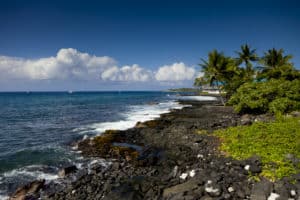Two centuries ago, when states like Kentucky and Vermont were struggling to achieve statehood, Hawaiian rulers still worshiped a powerful war god called Ku. King Kamehameha 1, who was engaged in a battle to control all the Hawaiian islands, sought Ku’s support when he ordered the construction of a massive stone temple 400 feet above Kawaihae Harbor in North Kohala. Apparently, human sacrifice, a common requirement of ruthless war gods, was part of the deal.
Puukohola Heiau Was a Stone Temple Used for War
Construction of Pu’ukohola, a 20-foot-tall lava rock heiau, or temple, was started in 1790 and completed a year later. By 1810, Kamehameha had conquered the Islands and established a monarchy. He died in 1819, after which his son abandoned the religious practices that had ruled Hawaii and ordered destruction of the temple.
Self Guided Tours are Available at this National Historic Site
Pu’ukohola is now a 77-acre National Historic Site operated by the National Park Service. One of the most imposing and dramatic Hawaiian temples in the island chain, it was built with mortarless stone and, when completed, measured 100 by 224 feet. Stones were passed along a human chain from neighboring areas such as Waipiʻo Valley. The temple has been largely restored and a self-guided tour of the grounds begins at the visitor center.
Puukohola Heiau Was Built in Response to a Prophecy
Kamehameha commanded thousands of workers to construct the temple on the advice of the prophet Kapoukahi, who said that Kamehameha would conquer all the islands only after he built a temple dedicated to his family war god. In the prophecy, war would end when the heiau was completed and a major chief had been sacrificed.
Puukohola Heiau Means Temple on the Hill of the Whale
Puʻukohola, which means Temple on the Hill of the Whale, is open daily from 7:30 a.m. to 4 p.m. Admission is free. The park is located 1 mile south of the harbor at Kawaihae on Hwy. 270. From Hwy. 19 bear left onto Hwy. 270 where the signs point to Kawaihae.






